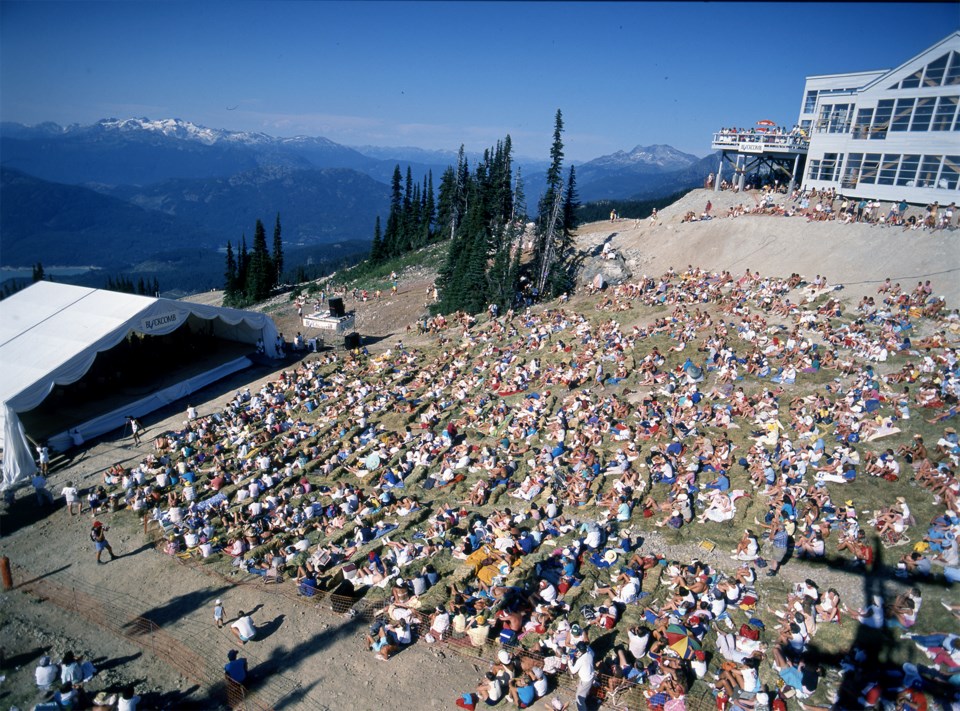While we might be used to busy summers in Whistler these days, in the 1970s and into the 1980s, visitor numbers would drop dramatically after the ski season ended in the late spring. As Whistler grew, the Whistler Resort Association (WRA) and other businesses and groups worked to make summers busier and transform Whistler into a four-season resort (you can learn more about the activities of the WRA on June 12, when the museum will be joined by Al Raine and Drew Meredith to discuss its origins and early years). By 1989, it appears the efforts proved somewhat successful, at least when looking at the summer season on Blackcomb Mountain.
According to the Blabcomb, Blackcomb Mountain’s employee newsletter, the summer of 1989 got off to a chilly start and, though there were good days, the colder-than-usual weather continued throughout the season. During the previous summer, Blackcomb Mountain received 30,107 skier visits and 61,598 non-skier visits. In 1989, however, officials expected the numbers to be slightly lower, as the season would be a couple weeks shorter, and Whistler Mountain would also be competing for visitors.
Along with sightseeing and hiking, Blackcomb Mountain offered various activities and events from June through Sept. 4, when summer operations ended. Ski-school programs continued on the glacier with beginner lessons for $35 (including lift ticket, lesson and rentals) and private lessons ranging from $80 to $210. There were also various camps throughout the summer that operated on the glacier. The Labatt’s Blue Summer Challenge Ski Race Series ran throughout July and the Canadian Summer Snowboard Championships took place on Blackcomb from July 13 to 15.
Skis and snowboards were not the only equipment moved via chair that summer. Though the Whistler Mountain Bike Park is celebrating its 25th anniversary this year, bikes were transported up lifts well before 1999. The summer of 1989 was at least the second year mountain biking played a large role in Blackcomb’s operations. Bikes were uploaded via the Wizard and Solar Coaster chairs (and, later in the summer, 7th Heaven, though that was for expert riders only) from 8:30 a.m. to 3:30 p.m. Tours ran twice daily from the Rendezvous Lodge for $5, though riders could also purchase a sightseeing pass and try out the Blackcomb bike trails on their own. If you had your own bike and seasons’ pass, it could cost as little as $5 to head up the lifts.
Like the Ski Race Series, the BCR Mountain Bike Race Series ran throughout July and into August. This was followed in mid-August by the 2nd Annual Labatt’s Can-Am Mountain Bike Challenge, which included the World Mountain Bike Polo Championship, and later by the Kokanee Glacier Light Prestige Biathlon, which featured running and biking.
The biggest event to happen on Blackcomb Mountain that summer did not involve skiing, riding or biking, as almost 6,000 people attended the Vancouver Symphony Orchestra’s performance 4,000 feet above Whistler Village on Aug. 12. The performance featured conductor Peter McCoppin and violinist Patricia Shih as well as some familiar pieces such as Vivaldi’s Four Seasons. According to the Blabcomb, the concert went smoothly, though the line-up to download at the end was quite long.
Though Blackcomb stayed open until September, the T-bars stopped running by Aug. 20, and events began to wind down. By Aug. 31, Blackcomb had received about 42,000 non-skier visits (well above the expected 35,000) and 24,100 skier visits (slightly lower than expected due to the earlier closure) and the Blabcomb declared the summer season a success.




